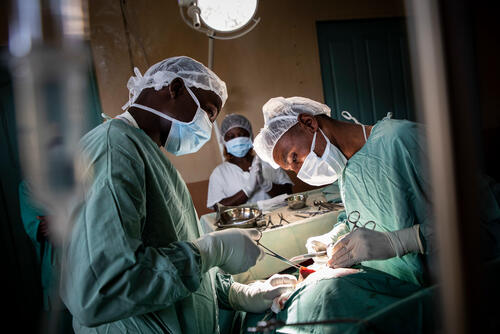Polytrauma care: Learn how to save a life in a conflict zone
There’s been an airstrike. The first of many critically injured people arrives at your hospital. You need to think fast and act fast. What do you do?
For Médecins Sans Frontières / Doctors Without Borders (MSF) medics working in conflict zones around the world, there is a life-saving system.
What is polytrauma?
Major trauma is any serious injury that can be life-threatening or life-changing due to disability. Polytrauma is when a patient has suffered several of these injuries, often in road traffic accidents, falls or acts of violence.
To MSF teams in humanitarian crises, this kind of trauma can often mean complex war-wounds: gunshots, blast injuries and burns.
From Sudan to Gaza, Yemen to the Democratic Republic of Congo, our staff are experts in emergency trauma care.
The golden hour
In trauma care, there’s an important concept known as ‘the golden hour’.
Most patients who do not get medical care in the first 60 minutes after a major traumatic injury will not survive their injuries.
The critical window for survival varies from patient to patient depending on their injuries, but the golden hour remains a fundamental principle of trauma care.
The (C)ABCDE protocol
The initial medical management of polytrauma follows a universal protocol that matches the first letters of the English alphabet.
Known as the ‘primary survey’, this rapid assessment is completed in just two to three minutes and includes the emergency interventions taken to stabilise a patient.
C | Catastrophic haemorrhage
We look for any high-volume, dangerous blood loss and take immediate action to stop the bleeding with dressings, pressure and tourniquets.
A | Airway
We assess a patient’s neck and upper spine, listen to their breathing and make sure their airway isn’t obstructed, swollen or collapsed. In some cases, this might require hard collars and headblocks to immobilise their neck and even emergency anaesthesia followed by intubation and breathing support.
B | Breathing
We check a patient’s breathing rate and oxygen level, and whether their chest is rising and falling as normal. We also look for signs of significant injury or deformity to their chest, including broken ribs or fluid on their lungs. This is very common in people who have suffered blast injuries. We will administer oxygen and perform a chest drain if needed. In higher-resource hospitals, we may be able to use devices such as a portable X-ray or ultrasound machine to help us get a better picture.
C | Circulation
We have already checked for catastrophic bleeding, but we now need to assess how much blood a patient may have lost. We’ll measure their heart rate and blood pressure, and identify potential internal bleeding and broken pelvic or limb bones. At this point, a patient may need an urgent blood transfusion and diagnostic blood tests to check for further serious conditions, while serious fractures will be fixed in place with splits.
D | Disability
In trauma care, assessing for disability means evaluating consciousness and potential brain or spinal injuries. If a patient is awake, we make a quick assessment of their alertness: Are they confused? Do they respond to visual stimuli or basic questions? What size are their pupils? Can they feel pain and move their limbs? We also check for low blood glucose levels, which could be affecting their consciousness.
E | Exposure
There are two ways in which we use the word exposure here: We check the patient for signs of hypothermia or hyperthermia and stabilise their body temperature. At the same time, we need to ‘expose’ their body and do a full check for any further injuries, serious burns, infections or signs of deterioration.
This list is not exhaustive, but it may give you an insight into those first moments of stabilising a polytrauma patient and the actions taken by MSF medics in emergency rooms around the world.
Beyond trauma care
From the moment of injury to being back to full health, MSF is working along that entire pathway.
After the emergency room, a patient with major trauma could then need urgent surgical intervention. Our operating theatre teams may need to carry out ‘damage control surgery’ to stop internal bleeding and keep a patient alive. Later, the same patient may require multiple operations to fix shattered bones, treat major burns with a skin graft or have limbs amputated.
Once a patient is stable enough to move again, physiotherapy or occupational therapy staff will help them learn to use their body again, or, in some cases, learn how to use their new body if they have lost a limb or require a prosthesis.
Finally, a fundamental part of comprehensive trauma care is mental health support. After a traumatic experience, the psychological injury can be truly significant, particularly for patients in conflict zones. Healing the mind and dealing with this very different kind of trauma may take time and care, but MSF mental health specialists are experts at supporting patients to process and manage the impact of the event.
We deliver life-saving, limb-saving care at every step of the journey.
